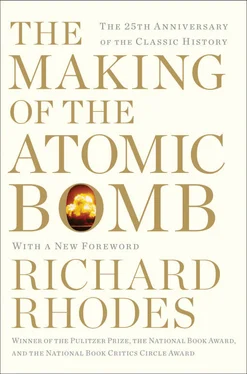Becoming a scientist is necessarily an act of profound commitment to the scientific system and the scientific world view. “Any account of science which does not explicitly describe it as something we believe in is essentially incomplete and a false pretense. It amounts to a claim that science is essentially different from and superior to all human beliefs that are not scientific statements—and this is untrue.” Belief is the oath of allegiance that scientists swear. 102
That was how scientists were chosen and admitted to the order. They constituted a republic of educated believers taught through a chain of masters and apprentices to judge carefully the slippery edges of their work.
Who then guided that work? The question was really two questions: who decided which problems to study, which experiments to perform? And who judged the value of the results?
Polanyi proposed an analogy. Imagine, he said, a group of workers faced with the problem of assembling a very large, very complex jigsaw puzzle. 103How could they organize themselves to do the job most efficiently?
Each worker could take some of the pieces from the pile and try to fit them together. That would be an efficient method if assembling a puzzle was like shelling peas. But it wasn’t. The pieces weren’t isolated. They fitted together into a whole. And the chance of any one worker’s collection of pieces fitting together was small. Even if the group made enough copies of the pieces to give every worker the entire puzzle to attack, no one would accomplish as much alone as the group might if it could contrive a way to work together.
The best way to do the job, Polanyi argued, was to allow each worker to keep track of what every other worker was doing. “Let them work on putting the puzzle together in the sight of the others, so that every time a piece of it is fitted in by one [worker], all the others will immediately watch out for the next step that becomes possible in consequence.” That way, even though each worker acts on his own initiative, he acts to further the entire group’s achievement. 104The group works independently together; the puzzle is assembled in the most efficient way.
Polanyi thought science reached into the unknown along a series of what he called “growing points,” each point the place where the most productive discoveries were being made. 105Alerted by their network of scientific publications and professional friendships—by the complete openness of their communication, an absolute and vital freedom of speech—scientists rushed to work at just those points where their particular talents would bring them the maximum emotional and intellectual return on their investment of effort and thought.
It was clear, then, who among scientists judged the value of scientific results: every member of the group, as in a Quaker meeting. “The authority of scientific opinion remains essentially mutual; it is established between scientists, not above them.” There were leading scientists, scientists who worked with unusual fertility at the growing points of their fields; but science had no ultimate leaders. 106Consensus ruled.
Not that every scientist was competent to judge every contribution. The network solved that problem too. Suppose Scientist M announces a new result. He knows his highly specialized subject better than anyone in the world; who is competent to judge him? But next to Scientist M are Scientists L and N. Their subjects overlap M’s, so they understand his work well enough to assess its quality and reliability and to understand where it fits into science. Next to L and N are other scientists, K and O and J and P, who know L and N well enough to decide whether to trust their judgment about M. On out to Scientists A and Z, whose subjects are almost completely removed from M’s.
“This network is the seat of scientific opinion,” Polanyi emphasized; “of an opinion which is not held by any single human brain, but which, split into thousands of different fragments, is held by a multitude of individuals, each of whom endorses the other’s opinion at second hand, by relying on the consensual chains which link him to all the others through a sequence of overlapping neighborhoods.” 107Science, Polanyi was hinting, worked like a giant brain of individual intelligences linked together. That was the source of its cumulative and seemingly inexorable power. But the price of that power, as both Polanyi and Feynman are careful to emphasize, is voluntary limitation. Science succeeds in the difficult task of sustaining a political network among men and women of differing backgrounds and differing values, and in the even more difficult task of discovering the rules of the chess game of the gods, by severely limiting its range of competence. “Physics,” as Eugene Wigner once reminded a group of his fellows, “does not even try to give us complete information about the events around us—it gives information about the correlations between those events.” 108
Which still left the question of what standards scientists consulted when they passed judgment on the contributions of their peers. Good science, original work, always went beyond the body of received opinion, always represented a dissent from orthodoxy. How, then, could the orthodox fairly assess it?
Polanyi suspected that science’s system of masters and apprentices protected it from rigidity. The apprentice learned high standards of judgment from his master. At the same time he learned to trust his own judgment: he learned the possibility and the necessity of dissent. Books and lectures might teach rules; masters taught controlled rebellion, if only by the example of their own original—and in that sense rebellious—work.
Apprentices learned three broad criteria of scientific judgment. 109The first criterion was plausibility. That would eliminate crackpots and frauds. It might also (and sometimes did) eliminate ideas so original that the orthodox could not recognize them, but to work at all, science had to take that risk. The second criterion was scientific value, a composite consisting of equal parts accuracy, importance to the entire system of whatever branch of science the idea belonged to, and intrinsic interest. The third criterion was originality. Patent examiners assess an invention for originality according to the degree of surprise the invention produces in specialists familiar with the art. Scientists judged new theories and new discoveries similarly. Plausibility and scientific value measured an idea’s quality by the standards of orthodoxy; originality measured the quality of its dissent.
Polanyi’s model of an open republic of science where each scientist judges the work of his peers against mutually agreed upon and mutually supported standards explains why the atom found such precarious lodging in nineteenth-century physics. It was plausible; it had considerable scientific value, especially in systematic importance; but no one had yet made any surprising discoveries about it. None, at least, sufficient to convince the network of only about one thousand men and women throughout the world in 1895 who called themselves physicists and the larger, associated network of chemists. 110
The atom’s time was at hand. The great surprises in basic science in the nineteenth century came in chemistry. The great surprises in basic science in the first half of the twentieth century would come in physics.
* * *
In 1895, when young Ernest Rutherford roared up out of the Antipodes to study physics at the Cavendish with a view to making his name, the New Zealand he left behind was still a rough frontier. British nonconformist craftsmen and farmers and a few adventurous gentry had settled the rugged volcanic archipelago in the 1840s, pushing aside the Polynesian Maori who had found it first five centuries before; the Maori gave up serious resistance after decades of bloody skirmish only in 1871, the year Rutherford was born. He attended recently established schools, drove the cows home for milking, rode horseback into the bush to shoot wild pigeons from the berry-laden branches of virgin miro trees, helped at his father’s flax mill at Brightwater where wild flax cut from aboriginal swamps was retted, scutched and hackled for linen thread and tow. He lost two younger brothers to drowning; the family searched the Pacific shore near the farm for months.
Читать дальше












